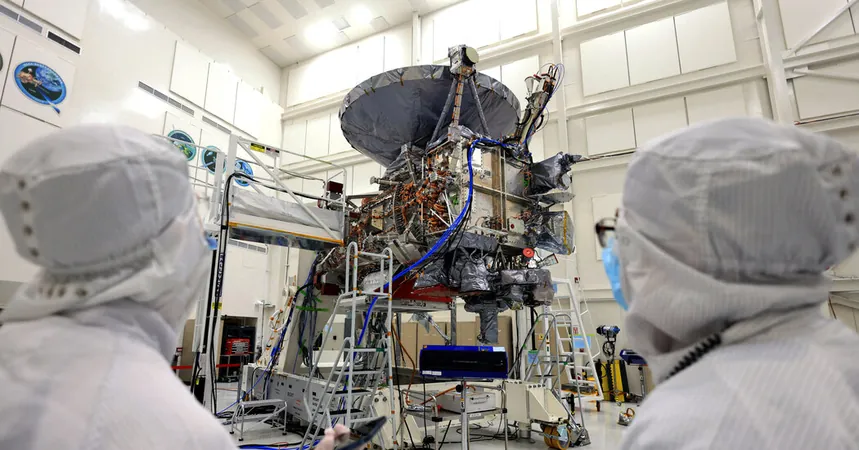
Is NASA's $5 Billion Europa Clipper Mission About to be Saved?
2024-09-17
Introduction
In the high-stakes world of NASA missions, an email marked "First Story" can send shivers down the spine of engineers and scientists alike. This spring, Curt Niebur, NASA's lead scientist for flight programs, experienced this jarring moment firsthand, catalyzing a tumultuous season for the Europa Clipper project.
Mission Overview
The Europa Clipper mission, boasting a formidable budget of over $5 billion, aims to explore Europa, one of Jupiter's moons, believed to harbor a vast subsurface ocean beneath its icy crust, potentially harboring the right conditions for alien life. As preparations neared completion — with plans to ship the spacecraft to Florida for an October launch — alarming news emerged about the critical components that could jeopardize the mission.
The MOSFET Crisis
An unsettling discovery revealed that MOSFETs, the transistors crucial for the spacecraft’s operations, were failing under the intense radiation they would encounter near Europa. These components function as on/off switches for the spacecraft’s systems, and their failure could plunge Europa Clipper into darkness. The implications were dire — if these transistors could not withstand even a fraction of the moon's extreme radiation, the mission itself could be doomed.
Immediate Action
Jordan Evans, the project manager, hastily assembled a “tiger team” of experts to investigate the potential failure rates and devise mitigation strategies. Under the leadership of veteran Soren Madsen, the team performed rigorous stress tests, confirming the troubling susceptibility of these MOSFETs to radiation damage.
The Scaling Problem
As the investigation deepened, the enormity of the issue hit hard: estimates jumped from around 900 to approximately 1,500 MOSFETs embedded within various systems of the spacecraft. Replacing or retrofitting each unit would not only drain resources but also consume years of precious time — two factors that could jeopardize the entire mission given the contentious landscape of NASA’s budgetary constraints.
Challenges Faced
Compounding problems, the tiger team faced the complex challenge that the various types of MOSFETs might behave differently under radiation. Hours turned into days of frantic analysis and calls — many engineers, like Geffrey Ottman from Johns Hopkins University, found themselves dedicating considerable off-hours to tackle the growing crisis.
Innovative Solutions
Meanwhile, innovative solutions emerged from the darkness. Joe Stehly, leading a secondary team tasked with devising solutions, ventured into the promising method of “annealing” — a heating process that could enable the transistors to recover to some degree after radiation exposure. Strategies included powering down certain systems during flybys to minimize burn-out, effectively extending the operational life of crucial components during the mission.
Progress and Inventions
By the end of July, updates were grim but hopeful; although many challenges loomed, potential solutions had begun to crystallize. A breakthrough came when a European subcontractor unearthed some engineering samples of the transistors that had previously gone missing. The team swiftly initiated testing on these samples, a move critical for determining the mission's viability.
The Canary Box Idea
Building on this momentum, an innovative idea dubbed the "canary box" surfaced. This concept involved installing a set of aged MOSFETs within a protective enclosure on the spacecraft to monitor their behavior throughout the flight. Should one type of MOSFET start to fail, engineers could adapt their strategies in real-time, fulfilling a critical safety measure to preserve the mission's objectives.
A Turning Point
A pivotal meeting in August with senior NASA executives yielded an optimistic outcome amid shadows of past setbacks. The once-colorful chart depicting the state of the project had transformed into a flurry of green cells, marking newfound confidence in the mission’s viability.
Mission Cleared
In a moment of palpable suspense, a consensus was reached to move forward. With unanimous agreement from NASA leadership, the Europa Clipper was cleared for launch, set to grace the launchpad on October 10th.
Conclusion
As decades of effort coalesce into this monumental moment, all eyes are on this ambitious spacecraft that aims to unlock the secrets of Europa, potentially paving the way for the next chapter in humanity’s search for extraterrestrial life. Will this daring mission discover hints of life beneath Europa's frozen surface, or will it face insurmountable challenges ahead? Brace yourself; the countdown to cosmic exploration has truly begun!






 Brasil (PT)
Brasil (PT)
 Canada (EN)
Canada (EN)
 Chile (ES)
Chile (ES)
 España (ES)
España (ES)
 France (FR)
France (FR)
 Hong Kong (EN)
Hong Kong (EN)
 Italia (IT)
Italia (IT)
 日本 (JA)
日本 (JA)
 Magyarország (HU)
Magyarország (HU)
 Norge (NO)
Norge (NO)
 Polska (PL)
Polska (PL)
 Schweiz (DE)
Schweiz (DE)
 Singapore (EN)
Singapore (EN)
 Sverige (SV)
Sverige (SV)
 Suomi (FI)
Suomi (FI)
 Türkiye (TR)
Türkiye (TR)